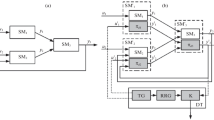Abstract
Test-based diagnosis of an arbitrary real-time computer system represented by a set of functionally related software modules executed on a single computer or concurrently on a set of computers is considered. The approach called diagnosis using a parallel model is used. An efficient procedure for test generation is proposed.
Similar content being viewed by others
References
R. J. Patton, P. M. Frank, and R. N. Clark, Issues in Fault Diagnosis for Dynamic Systems (Springer, London, 2000).
R. Isermann, Fault Diagnosis Application (Springer, Heidelberg, 2011).
L. A. Mironovskii, Functional Diagnosis of Dynamical Systems (MGU-GRIF, Moscow, St. Petersburg, 1998) [in Russian].
N. V. Kolesov, M. V. Tolmacheva, and P. V. Yukhta, Real Time Systems. Planning, Analysis, Diagnosis (Elektropribor, St. Petersburg, 2014) [in Russian].
E. Chanthery and Y. Pencolé, “Monitoring and active diagnosis for discrete-event systems,” in Proceedings of the 7th IFAC Symposium on Fault Detection, Supervision and Safety of Technical Processes (Barcelona, Spain, 2009), pp. 1545–1550.
H. Niemann, “Fault tolerant control based on active fault diagnosis,” in Proceedings of the American Control Conference (Portland, OR, USA, 2005), pp. 2224–2229.
L. A. Mironovskii and V. A. Slaev, “Optimal test signals as a solution of the generalized Bulgakov problem,” Autom. Remote Control 63, 568–577 (2002).
G.-V. Jourdan and G. V. Bochmann, “On testing 1-safe Petri nets,” in Proceedings of the 3rd IEEE International Symposium on Theoretical Aspects of Software Engineering (Tianjin, China, 2009), pp. 275–281.
M. Pocci, I. Demongodin, N. Giambiasi, and A. Giua, “Testing discrete event systems: synchronizing sequences using Petri nets,” in Proceedings of the European Modeling and Simulation Symposium EMSS10 (Fes, Morocco, 2010).
M. Pocci, I. Demongodin, N. Giambiasi, and A. Giua, “Testing experiments on synchronized Petri nets,” IEEE Trans. Autom. Sci. Eng. 11, 125–138 (2014).
C. G. Cassandras and S. Lafortune, Introduction to Discrete Event Systems, 2nd ed. (Springer, New York, 2007).
R. Debouk, S. Lafortune, and D. Teneketzis, “Coordinated decentralized protocols for failure diagnosis of discrete-event systems,” Discrete Event Dyn. Syst.: Theory Appl., No. 10, 33–79 (2000).
M. Dotoli, M. P. Fanti, and A. M. Mangini, “Fault detection of discrete event systems using petri nets and integer linear programming,” in Proceedings of the 17th IFAC World Congress (Seoul, Korea, 2008).
E. Garcia, A. Correcher, F. Morant, E. Quiles, and R. Blasco, “Modular fault diagnosis based on discrete event systems,” Discrete Event Dyn. Syst., No. 15, 237–256 (2005).
S. Genc and S. Lafortune, “Distributed diagnosis of place-bordered Petri nets,” IEEE Trans. Autom. Sci. Eng., No. 4, 206–219 (2007).
S. Lai, D. Nessi, M. P. Cabasino, A. Giua, and C. Seatzu, “A comparison between two diagnostic tools based on automata and Petri nets,” in Proceedings of the 9th Workshop on Discrete Event Systems WODES’08, Göteborg, Sweden, 2008, pp. 144–149.
J. Zaytoon and S. Lafortune, “Overview of fault diagnosis methods for discrete event systems,” Ann. Rev. Control 37, 308–320 (2013).
A. M. Gruzlikov, N. V. Kolesov, Yu. M. Skorodumov, and M. V. Tolmacheva, “Time variant dynamic models in diagnosing of real-time computer systems,” J. Comput. Syst. Sci. Int. 53, 867 (2014).
A. M. Gruzlikov, N. V. Kolesov, and M. V. Tolmacheva, “Event monitoring of parallel computations,” Int. J. Appl. Math. Comput. Sci. 25, 311–321 (2015).
A. M. Gruzlikov and N. V. Kolesov, “Discrete-event diagnostic model for a distributed computational system. Independent chains,” Autom. Remote Control 77, 1805 (2016).
A. M. Gruzlikov and N. V. Kolesov, “Discrete-event diagnostic model for a distributed computational system. Merging chains,” Autom. Remote Control 78, 682 (2017).
P. Colaneri and S. Longhi, “The realization problem for linear periodic systems,” Automatica 31, 775–779 (1995).
A. Varga, “Periodic Lyapunov equations: some applications and new algorithms,” Int. J. Control 67, 69–87 (1997).
A. Gill, Linear Sequential Circuits (McGraw-Hill, New York, 1966).
Author information
Authors and Affiliations
Corresponding author
Additional information
Original Russian Text © A.M. Gruzlikov, N.V. Kolesov, E.V. Lukoyanov, 2018, published in Izvestiya Akademii Nauk, Teoriya i Sistemy Upravleniya, 2018, No. 3, pp. 76–89.
Rights and permissions
About this article
Cite this article
Gruzlikov, A.M., Kolesov, N.V. & Lukoyanov, E.V. Test-Based Diagnosis of Faults in Data Exchange Addressing in Computer Systems Using Parallel Model. J. Comput. Syst. Sci. Int. 57, 420–433 (2018). https://doi.org/10.1134/S1064230718030024
Received:
Accepted:
Published:
Issue Date:
DOI: https://doi.org/10.1134/S1064230718030024




